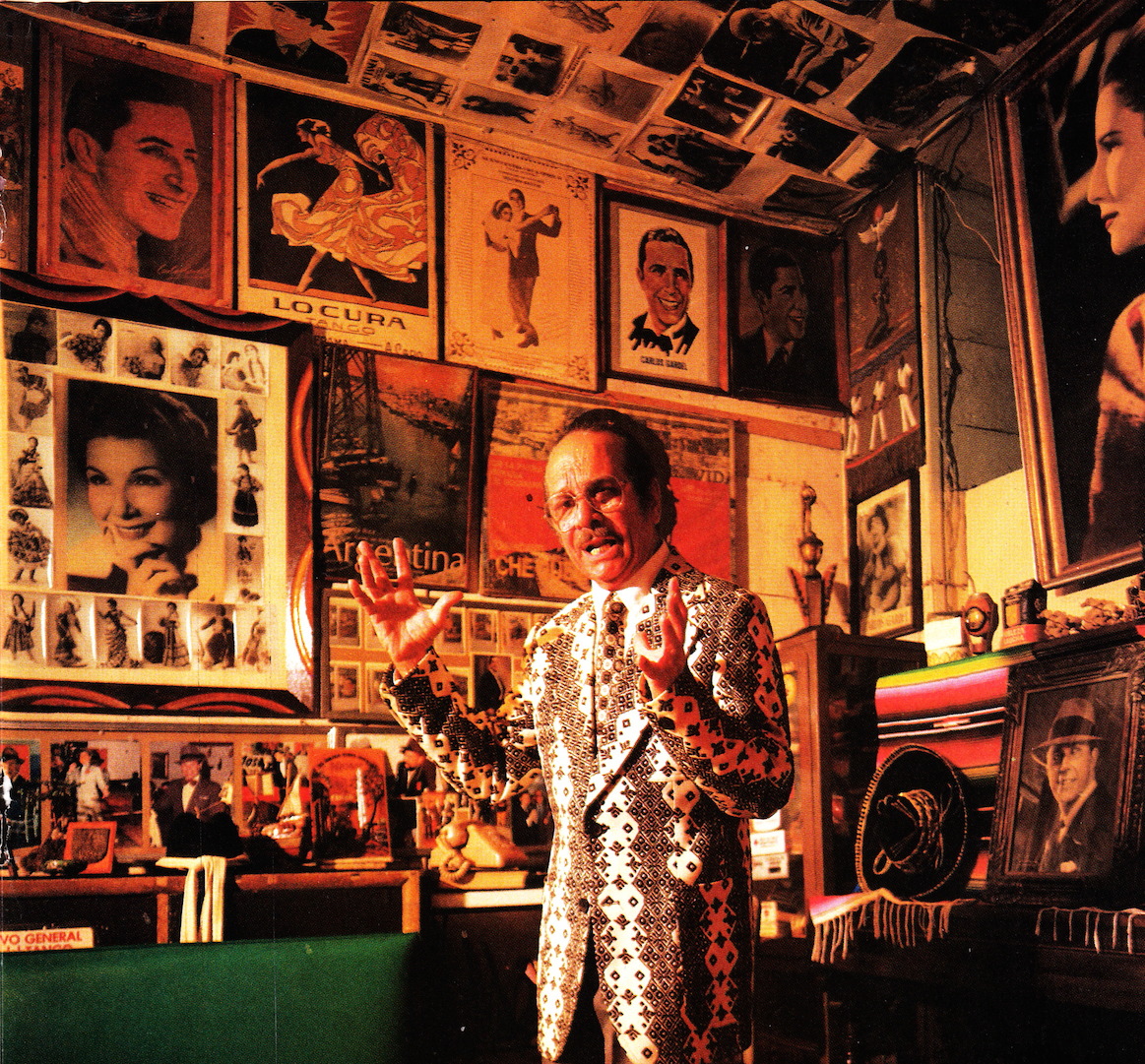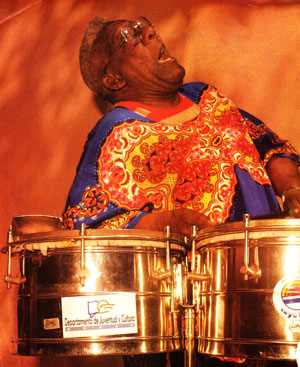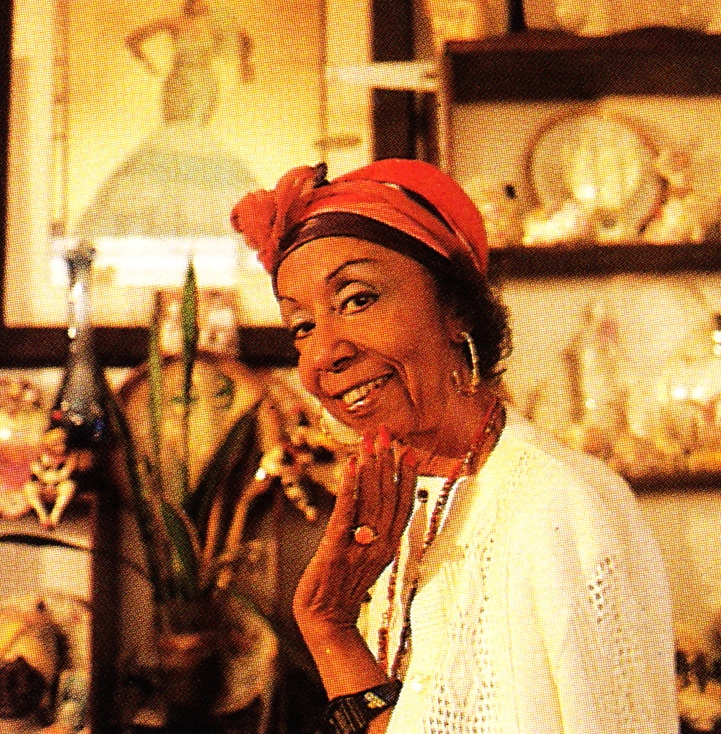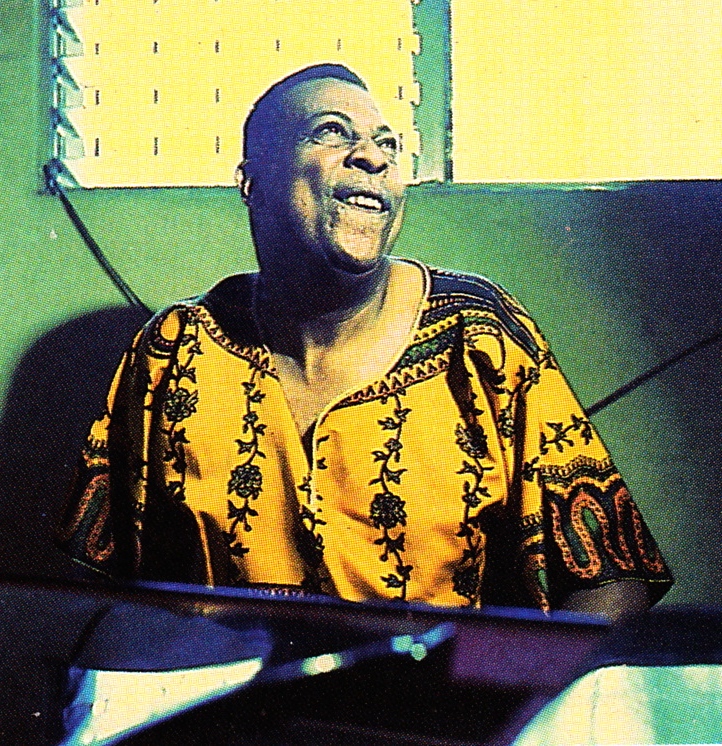Music journalism, books and more
Music Feature: Ay Caramba! - Music in Cuba
Behind a dilapidated storefront in central Havana, an ancient ritual is under way. An old black man, sitting in a crumbling shell of a room, instructs four initiates in the art of traditional Yoruba drumming. Beneath the glare of a dangling light bulb, Elpidio Acea barely seems up to the task. Wiry and wizened, he looks like he’d have trouble keeping a heartbeat, let alone a tricky West African rhythm. But striking two cigar-shaped sticks together, he taps out the offbeat pattern that signs the drums to begin. His students, all young women, respond with a sudden flurry of beats. Today’s lesson is the guaguancó, one of the most complex of all Afro-Cuban rhythms. And two of the students can’t keep it going. Patients, Elpidio starts again, remind the women to let the rhythm slowly build up steam. This time, the drumming gradually gathers momentum until it rumbles like a thundering train.
 Around the corner from Elpidio’s, the operatic strains of a tango dance out of an open doorway. Inside, Edmundo Daubar is paying homage to his hero, the late Argentine star Carlos Gardel. Singing to a scratchy Gardel recording, one of 750 in his private collection, the pint-sized septuagenarian is blissfully lost in the past. He calls his three-room apartment, wallpapered in photos and memorabilia, La Casa del Tango. And although it’s more of a personal shrine than a museum, he welcomes visitors in, to share a glass of rum and admire his souvenirs. Edmundo longs to see Argentina and visit Gardel’s grave. It’s a dream he may never realize, given travel costs and the scarcity of exit visas. Raising a toast to his hero’s portrait, a misty-eyed Edmundo repeats his well-worn credo that life, after all, is a tango.
Around the corner from Elpidio’s, the operatic strains of a tango dance out of an open doorway. Inside, Edmundo Daubar is paying homage to his hero, the late Argentine star Carlos Gardel. Singing to a scratchy Gardel recording, one of 750 in his private collection, the pint-sized septuagenarian is blissfully lost in the past. He calls his three-room apartment, wallpapered in photos and memorabilia, La Casa del Tango. And although it’s more of a personal shrine than a museum, he welcomes visitors in, to share a glass of rum and admire his souvenirs. Edmundo longs to see Argentina and visit Gardel’s grave. It’s a dream he may never realize, given travel costs and the scarcity of exit visas. Raising a toast to his hero’s portrait, a misty-eyed Edmundo repeats his well-worn credo that life, after all, is a tango.
A walk through Havana’s neighbourhoods, or barrios, is an adventure for anyone with open ears. Cuban music, a fruitful marriage of African and Spanish traditions, comes in more than a dozen distinct styles, including bolero, danzón, guajira and son. And in these desperate times of empty stores and rationed food, music remains in abundance for Cubans, lifting spirits and instilling pride. As Edmundo will tell you, even his beloved tango has its roots in a 19th-century Cuban form known as habanera. North Americans are more familiar with the rumba, the mambo and the cha-cha-cha, all dance crazes of the 1940s and ’50s that were featured in the recent hit movie The Mambo Kings. But there’s always been evidence of Cuban rhythms in Western music, in everything from Dizzy Gillespie’s bebop jazz to David Byrne’s global pop.
Recognizing a hard currency opportunity when it hears one, Cuba’s government is now selling rumba rhythms as a major tourist attraction. Havana’s jazz festival, held in February, is already a package tour hit, drawing groups from Canada and Europe. But now, the government is looking to draw visitors year-round, with regular music events. This month, the Festival of Contemporary Music takes place in Havana, featuring many of Cuba’s top performers. Then in November, Guanabacoa’s Festival of the Spirits celebrates the Afro-Cuban version of voodoo known as santeriá, with ritual chants, dance, percussion and music. Next January. The ministry of culture is offering visitors courses in various styles of Cuban music, everything from santeriá to salsa, as well as percussion lessons with some of the country’s master drummers.
Ask Canadians to name one Cuban song and they’ll likely come up with “Guantánamera,” the folk tune popularized by Pete Seeger and sung by strolling trovadores at Varadero resorts. Those old enough to remember might mention “El Manicero,” better known as “The Peanut Vendor,” a huge dance hit in North America during the 1930s. But few will be familiar with “Mama Inés,” perhaps the most popular song in Cuban history. In the National Museum of Music in Old Havana, there’s a 1940s recording of it sitting on an old gramophone, waiting to be played. A museum attendant obliges, cranks up the machine and places the giant needle on the 78. It’s a “tango conga” number, sung by the late Rita Montaner, a singer-actress and one of Cuba’s most popular performers. As the sassy, rhythmic tune pours out of the speaker, three Cuban teenage girls standing nearby start moving their hips and singing along. When they realize a group of tourists are watching, they break into a fit of giggles.
In the next room, drums—some taller than schoolgirls—fill massive glass cabinets. Carved and painted with snakes and geometric tribal markings, they are the musical legacy of Cuba’s African past. As Cuban musicians are fond of pointing out, drums were never banned in Cuba, the way they were in the United States, where slave owners feared the tribal music would stir up insurrections. Consequently, Cuban music is infinitely richer in rhythms. Some of the strongest come from the island’s eastern end, places such as Santiago de Cuba and Guantánamo, the birthplace of Elio Revé.
 An ebony-skinned former dockworker with the flattened nose of a boxer, Revé is one of Cuba’s leading musical stars. Like Tito Puente, the Puerto Rican salsa artist, Revé plays timbales and fronts his own large band. The oldest of 23 brothers and sisters, he grew up in a world steeped in santeriá. And he learned the complex drum patterns at ceremonies in his hometown. Now 63, Revé is revered as the leading exponent of sonchangui, a driving Afro-Cuban dance music. His recordings can be heard booming out of barrio-blasters, taxicabs and clubs around Havana. And his band, Charangón de Cuba, often plays at La Tropical, a pink 1950s outdoor beer garden with a boisterous reputation that packs in thousands on weekends.
An ebony-skinned former dockworker with the flattened nose of a boxer, Revé is one of Cuba’s leading musical stars. Like Tito Puente, the Puerto Rican salsa artist, Revé plays timbales and fronts his own large band. The oldest of 23 brothers and sisters, he grew up in a world steeped in santeriá. And he learned the complex drum patterns at ceremonies in his hometown. Now 63, Revé is revered as the leading exponent of sonchangui, a driving Afro-Cuban dance music. His recordings can be heard booming out of barrio-blasters, taxicabs and clubs around Havana. And his band, Charangón de Cuba, often plays at La Tropical, a pink 1950s outdoor beer garden with a boisterous reputation that packs in thousands on weekends.
Lounging poolside at Hotel Presidente during this year’s jazz festival, the gruff-voiced, beer-drinking Revé was explaining clave, the rhythm played on cigar-like sticks that is the foundation of al Cuban music. Clapping his massive, calloused hands together, he demonstrated the beat—one-two, one-two-three. “Every Cuban knows this rhythm,” he said. “You hear it everywhere, from when you’re born to when you die.”
Over on La Rampa that night, clave is all over the street. Cubans, cruising up and down the popular neon-lit strip of hotels and restaurants, are walking and talking in the clave rhythm. Even cars seem to be honking to its distinctive beat. At concerts, Cubans never clap on the beat or the after-beat. They clap in clave. For them, it’s as natural as breathing. But put two Cuban drummers together, one from the east and one from the west, and all hell breaks loose. Revé, for instance, favours the eastern 2/3 variation, while Enriqué Pla, drummer for the Havana-based supergroup Irakere, is strictly a 3/2 man. Pla got embroiled in a clave controversy during a percussion workshop at last February’s jazz festival. A drummer in the audience disagreed that his was the correct version. Tempers rose as others joined in the debate, which raged for over an hour. When asked what both versions would sound like if played simultaneously, Pla answered bluntly: an ugly war of rhythms.
 It’s Valentine’s Day in Havana. Not a Hallmark card in sight. Here they call it St. Valentine’s, and it’s a serious holiday. Down on the Malecón, a freeway-sixed lover’s lane that runs along Havana’s seafront, couples are out in force for el dia d’amor. Some are necking by the sea wall, under the spray of ocean waves. Others are gathered at a stage below the stately Hotel Nationál for a concert by Grupo Moncada, a popular band with roots in the New Song Movement of the 1960s. In a comfortable nearby restaurant at sunset, a tiny wisp of a woman with mischievous eyes and long, slender fingers is pouring precious seven-year dark rum on the floor. “It’s for Ochún, the goddess of love,” she explains, before filling several glasses.
It’s Valentine’s Day in Havana. Not a Hallmark card in sight. Here they call it St. Valentine’s, and it’s a serious holiday. Down on the Malecón, a freeway-sixed lover’s lane that runs along Havana’s seafront, couples are out in force for el dia d’amor. Some are necking by the sea wall, under the spray of ocean waves. Others are gathered at a stage below the stately Hotel Nationál for a concert by Grupo Moncada, a popular band with roots in the New Song Movement of the 1960s. In a comfortable nearby restaurant at sunset, a tiny wisp of a woman with mischievous eyes and long, slender fingers is pouring precious seven-year dark rum on the floor. “It’s for Ochún, the goddess of love,” she explains, before filling several glasses.
Merceditas Valdés knows her goddesses. A popular singer from the days before the revolution, Merceditas chose to remain in her country after Castro took power—unlike Celia Cruz, who fled to the United States to become a salsa star in the 1960s. Today, Merceditas is a national treasure, known as the queen of santeriá for the role she’s played in bringing songs for the spirits, or orishas, into popular Cuban culture. Eventually, everyone in the restaurant, a hard-currency establishment aimed at foreign-travelling nationals, recognizes the regal presence in their midst. Insisting she sing for them, the customers are treated to a gentle praise song for Ochún. As her willowy voice floats out, a hush fall over the room. Merceditas leaves a few minutes later, taking the spell with her, and the restaurant’s clatter resumes.
Back on the Malecón at nightfall, Madonna is in the air. Young Cubans, drawn to American consumer items like Nike and Levi’s, have also developed a taste for brand-name Western pop. To keep its constituents happy, the Young Communist League has set up a mobile disco in the barrio’s vacant lot. Below some serious scaffolding, complete with strobes and coloured lights, several hundred kids are kicking up the dust to the sounds of Kris Kross and Michael Jackson. Before shutting down at midnight, DJ Rafael explains the nature of his gig: he’s under contract to the YCL, which pays him to run dances around the country. Recently, he says, he was spinning discs for 5,000 rap-hungry kids in Santiago.
Last stop is Maxim’s, an after-hours club in Vedado, not far from the Plaza de la Revolución. Maxim’s has a distinct underground feel. A dark, smoky establishment, it’s the type of joint that serves only rum—no mix, no ice—and the house band, Los D’Siempre, plays hot, freewheeling American jazz, laced with plenty of Cuban percussion. On the dance floor, bodies in neon spandex and black-market denim are entwined in a sexy, swirling blur. As the band hits a climax, with sax honking in the best Coltrane tradition, the club is plunged into sudden darkness. It’s another one of Havana’s all-too-frequent power cuts. But that doesn’t stop the drums—or the dancers, who carry on amid squeals of delight.
 On the jazz festival’s closing night, an all-star lineup, including Revé, Irakere’s Jesus (Chucho) Valdés and Van Van’s Juan Formell, is paying a tribute to the late Beny Moré, one of the fathers of Cuban song. It’s a fitting finale, one that spans the island’s entire pantheon of styles. But the night’s not over yet. As if to show the real source of the music, Chucho leads a conga line out into the street. A classically trained pianist and the festival’s president besides, Chucho doesn’t look at all the part. A tall, elegant man with a gentle face, he’s dressed more for a cocktail reception than a street party. Yet, chanting and dancing in the middle of the crowd, he seems completely at ease. Later, wiping his wet brow, Chucho says he was simply following the spirit of the music.
On the jazz festival’s closing night, an all-star lineup, including Revé, Irakere’s Jesus (Chucho) Valdés and Van Van’s Juan Formell, is paying a tribute to the late Beny Moré, one of the fathers of Cuban song. It’s a fitting finale, one that spans the island’s entire pantheon of styles. But the night’s not over yet. As if to show the real source of the music, Chucho leads a conga line out into the street. A classically trained pianist and the festival’s president besides, Chucho doesn’t look at all the part. A tall, elegant man with a gentle face, he’s dressed more for a cocktail reception than a street party. Yet, chanting and dancing in the middle of the crowd, he seems completely at ease. Later, wiping his wet brow, Chucho says he was simply following the spirit of the music.
And back in Elpidio’s run-down rehearsal room, the spirits of santeriá are still being served. Standing over their battered, hand-painted conga drums, Elpidio’s students are running through their rumba rhythms. The four women, part of a group called Omi Aché, after the orisha of the sea, are practicing for a Sunday ceremony. Wilma Brydson, a journalism student from the local university, says it’s unusual for Cuban women to play percussion. They’re the first group of this kind. Elpidio, with clave sticks in hand, pauses to light a cigarette and says: “They dream of turning professional. And no doubt they will.”
His face disappears momentarily in a cloud of smoke. “After all,” he adds, “this music is in their blood.” Outside, where the shadows have grown long, workers wait patiently for the bus that never seems to come. Around the corner, there’s a crowd lining up for the rationed meat. And Omi Aché’s drums are echoing through the maze of narrow streets.
* * * * *
What’s a Guaguancó?
All you need for a Cuban musical vacation is a pair of willing ears and some dancing shoes. But to help keep track of the dizzying array of styles and rhythms, here’s a short glossary of terms:
Cha-cha-cha – A slower mambo, its basic move is a double step between the fourth and first beats.
Conga – With its heavy fourth beat, this is the dance of choice at carnivals all over the Caribbean. But it was born in Santiago de Cuba, the country’s most African city.
Danzón – Nineteenth-century Cuban ballroom music, characterized by the stately flute and strings.
Guajira – A rural style, it’s played on guitars with heartbreaking Hispanic melodies sung by artists like Celina Gonzáles, Cuba’s answer to Patsy Cline.
Mambo – An Afro-Cuban form, it became the signature sound of many a brassy big band in the 1950s and the rhythmic fuel for many an Arthur Murray dance lesson since.
Rumba – Highly African, with three lively, syncopated rhythms: the yambú, columbia and guaguancó. Best heard in Havana on “Rumba Saturdays,” or in Matanzas, where the group Los Muñequitos de Matanzas rules.
Son – Cuba’s most classic Afro-Cuban form, with a near-perfect blend of African and Hispanic influences. Made famous by bands like Septeto Nacional, the son has influence music the world over.
A Brief Discography
There are now a number of excellent recordings on the market featuring the cream of Cuba’s musical talent. This selection will prepare you for the sounds that await:
Cuba-Fully Charged (Earthworks) Rare grooves by Rumbavana and Sierra Maestra alongside the inspired work of pianist Adalberto Alvarez and his group.
Dancing with the Enemy (Luaka Bop) Featuring Elio Revé’s hot changüi, the Platters-like harmonies of Los Zafiros and former Tropicana star Celeste Mendoza.
A Carnival of Cuban Music (Rounder) Mixes Los Muñequitos de Matanzas with border-crossing tunes like “El Manicero (The Peanut Vendor).”
Diablo al Infierno! (Luaka Bop) A cross-section of new Cuban music, including salsa group Dan Den, a capella outfit Vocal Sampling—even a heavy-metal band called Zeus.
Cuban Dance Party (Rounder) Showcases great acts like guitarist Isaac Oveido and Irakere.
Finally, there’s Canadian saxophonist Jane Bunnett’s Spirits of Havana (Denon). Recorded in Havana with Merceditas Valdés and drummers Grupo Yoruba Andabo, it is spellbinding and a fine testament to the power of Cuban music.
Originally published in Destinations magazine, October 1993
All photography © Russell Monk


